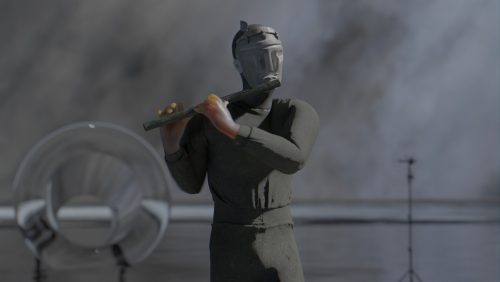
Lulù Nuti
Tube
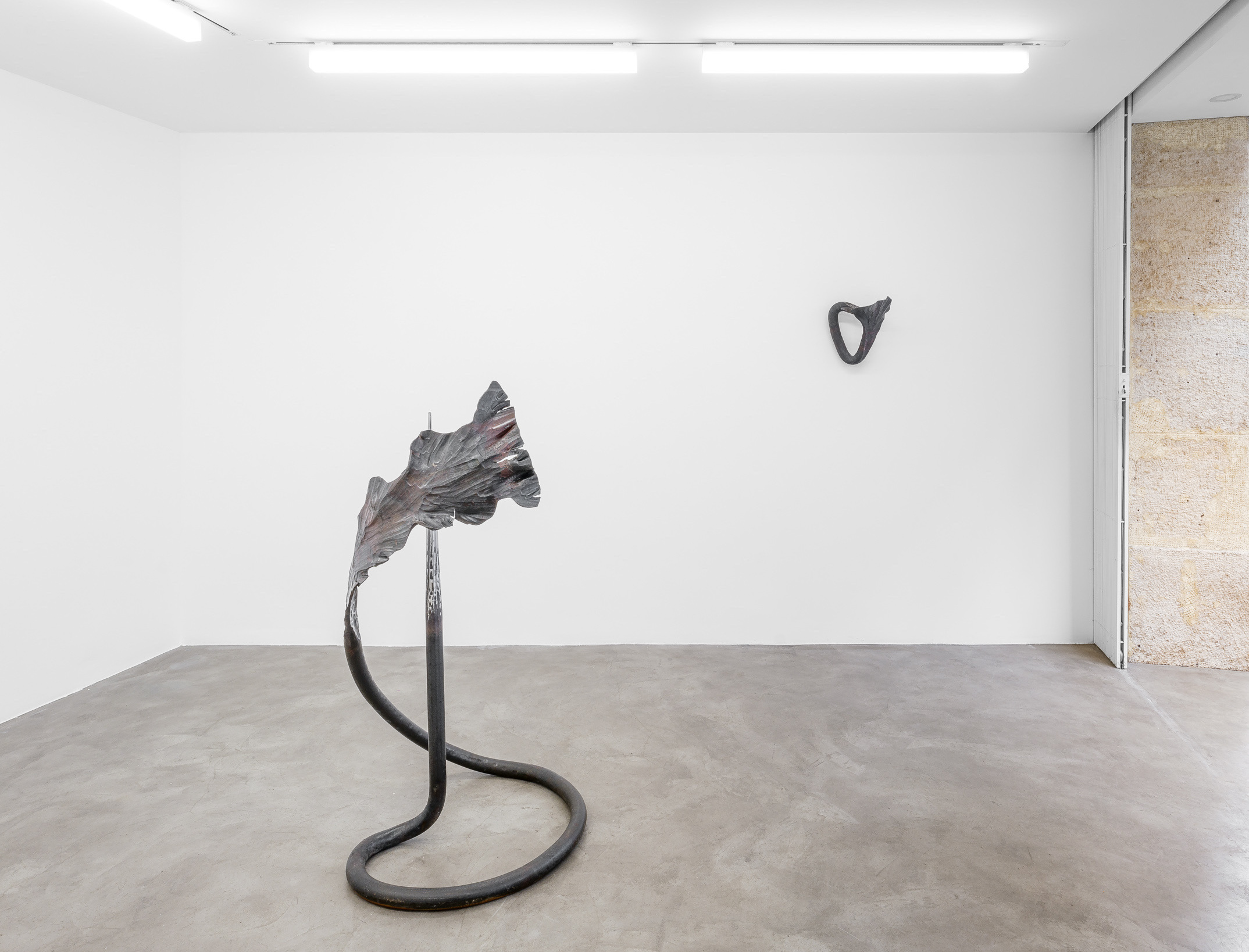
Advertisement

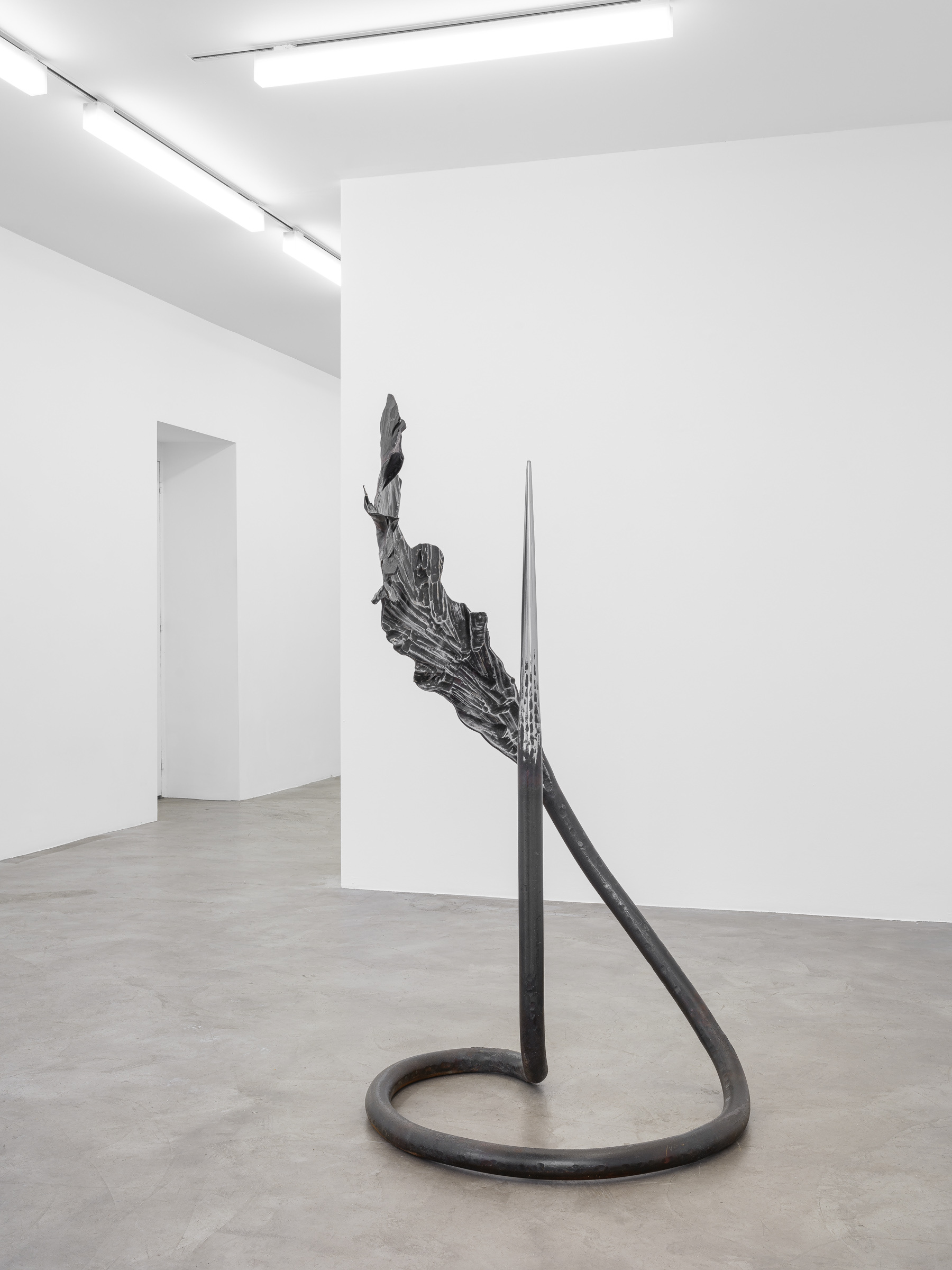
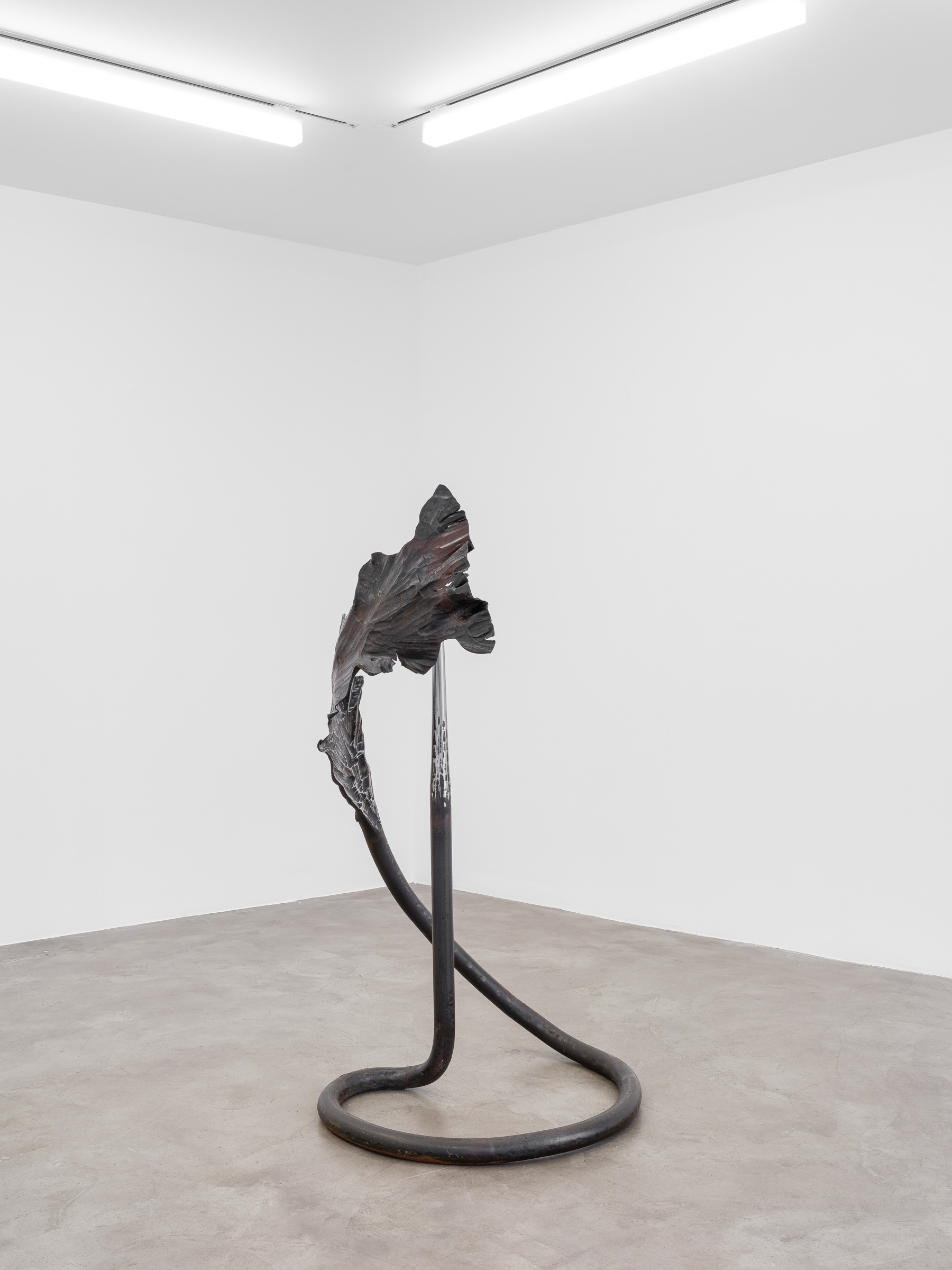
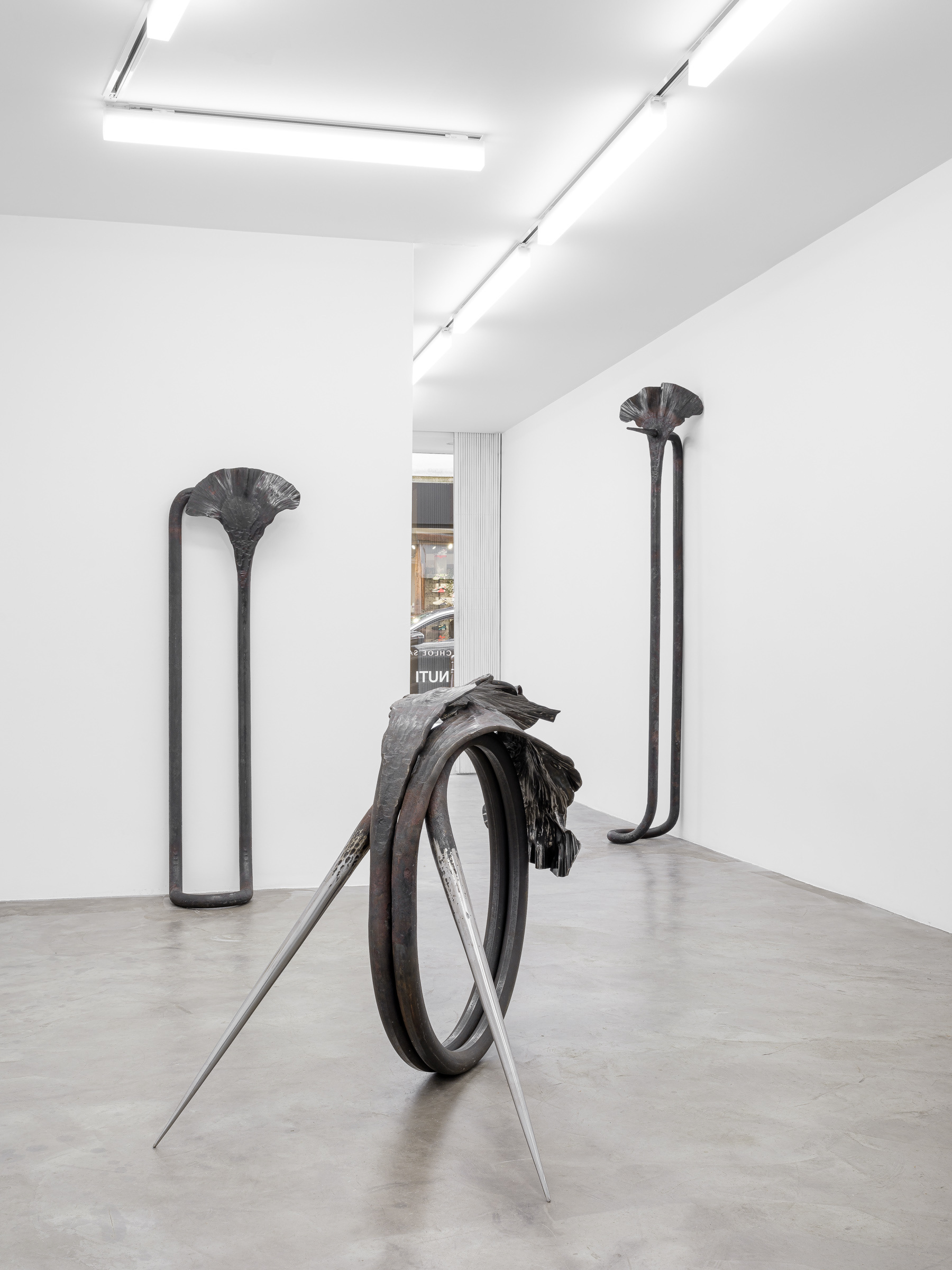
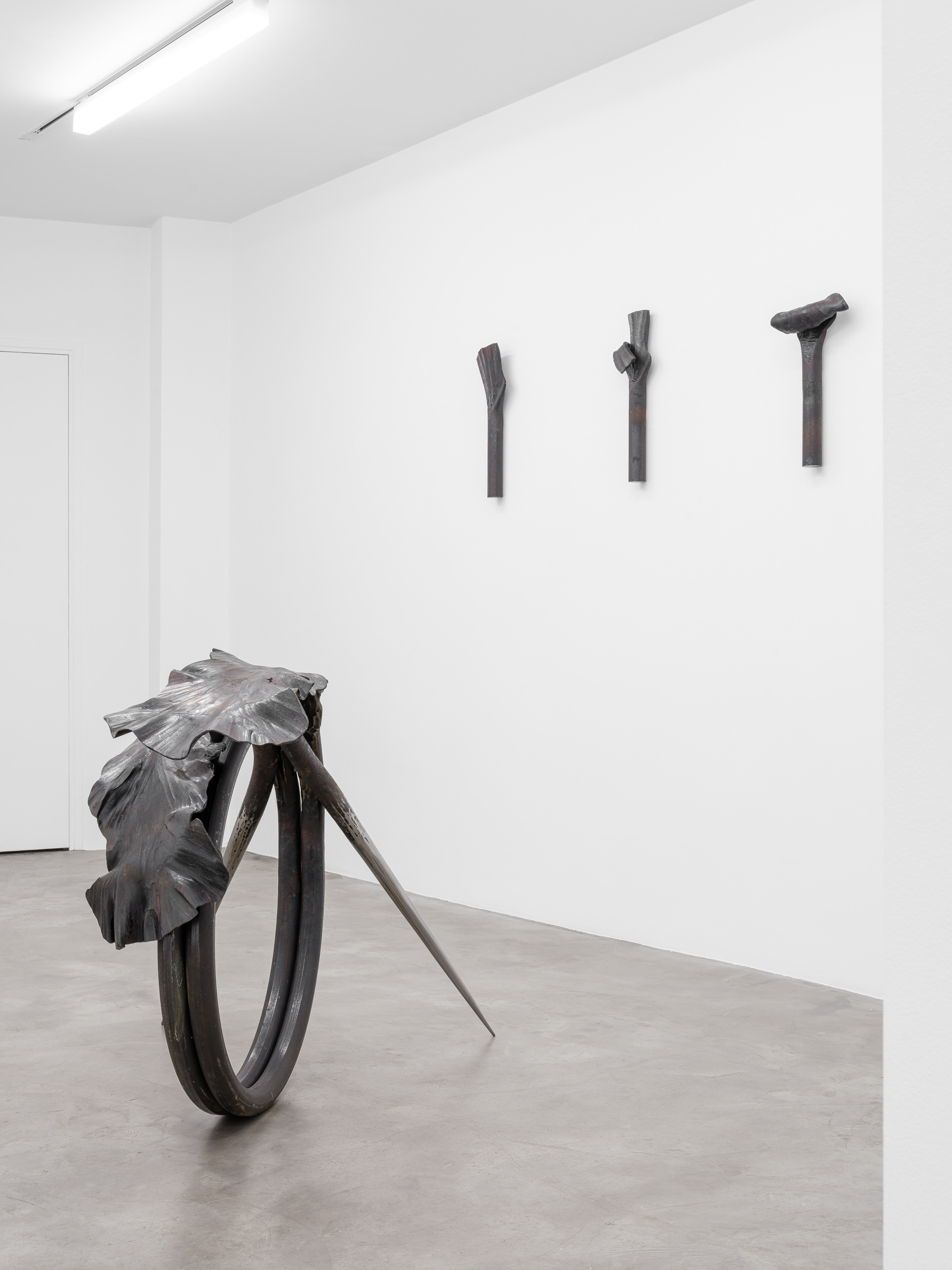
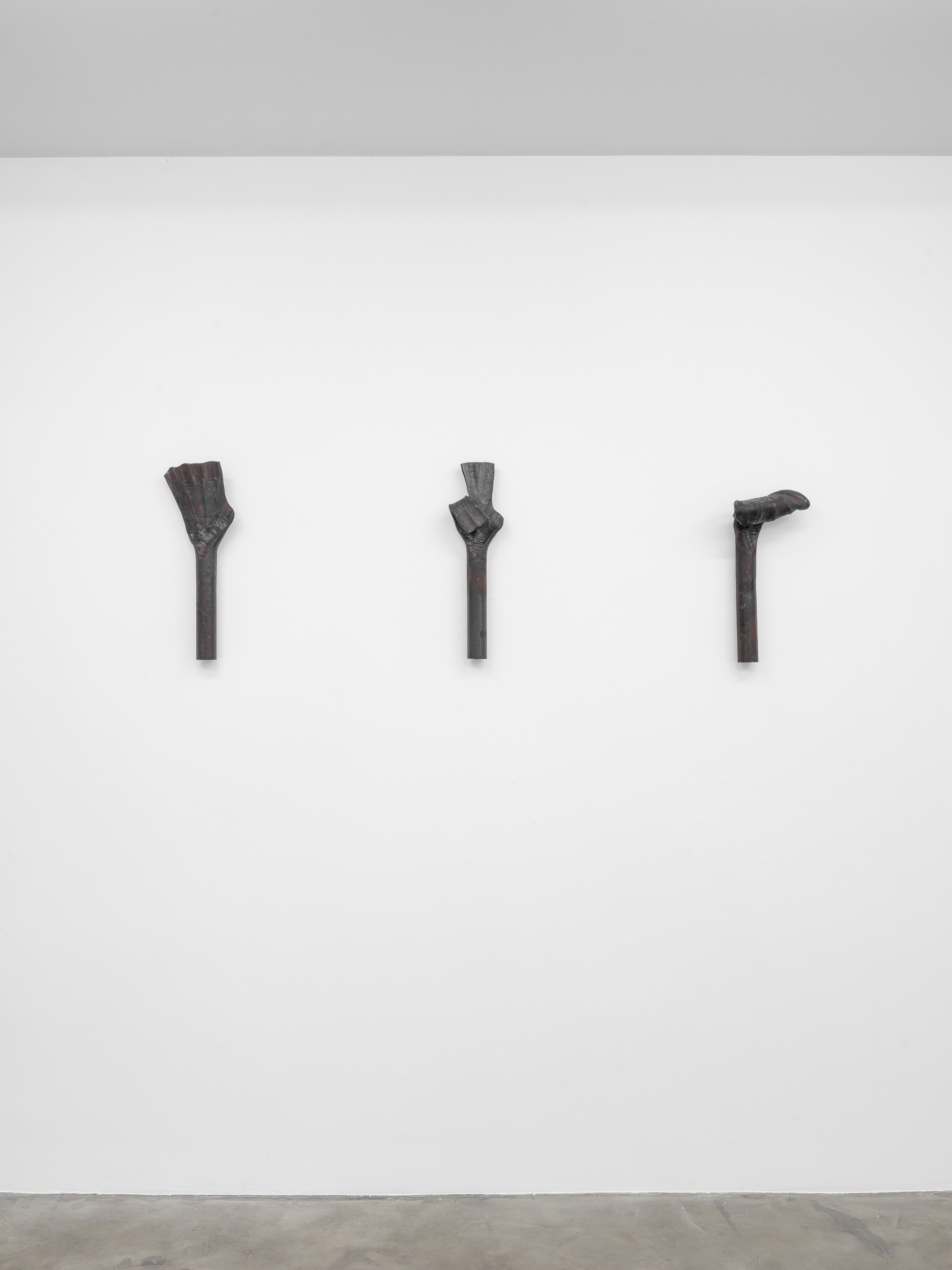
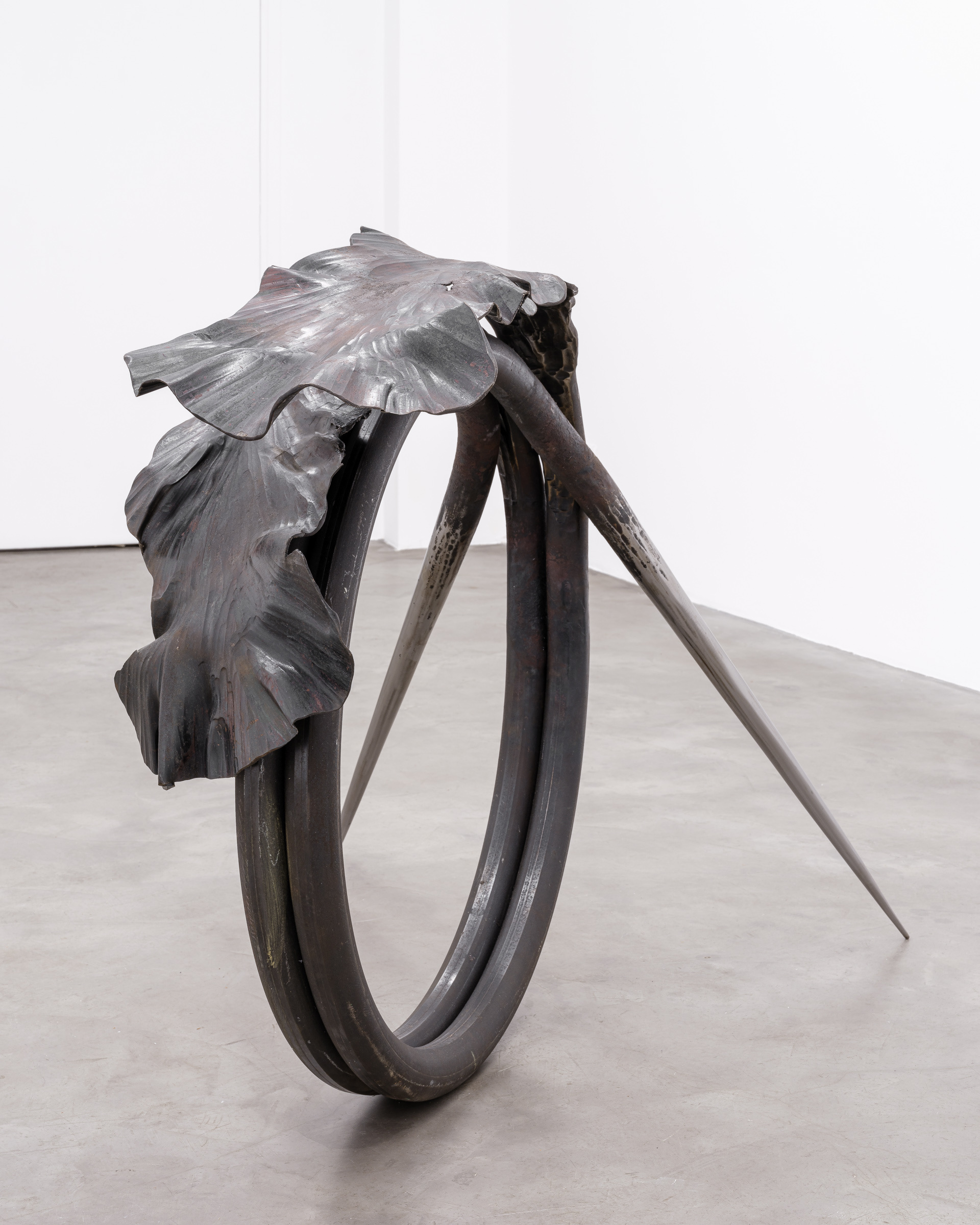

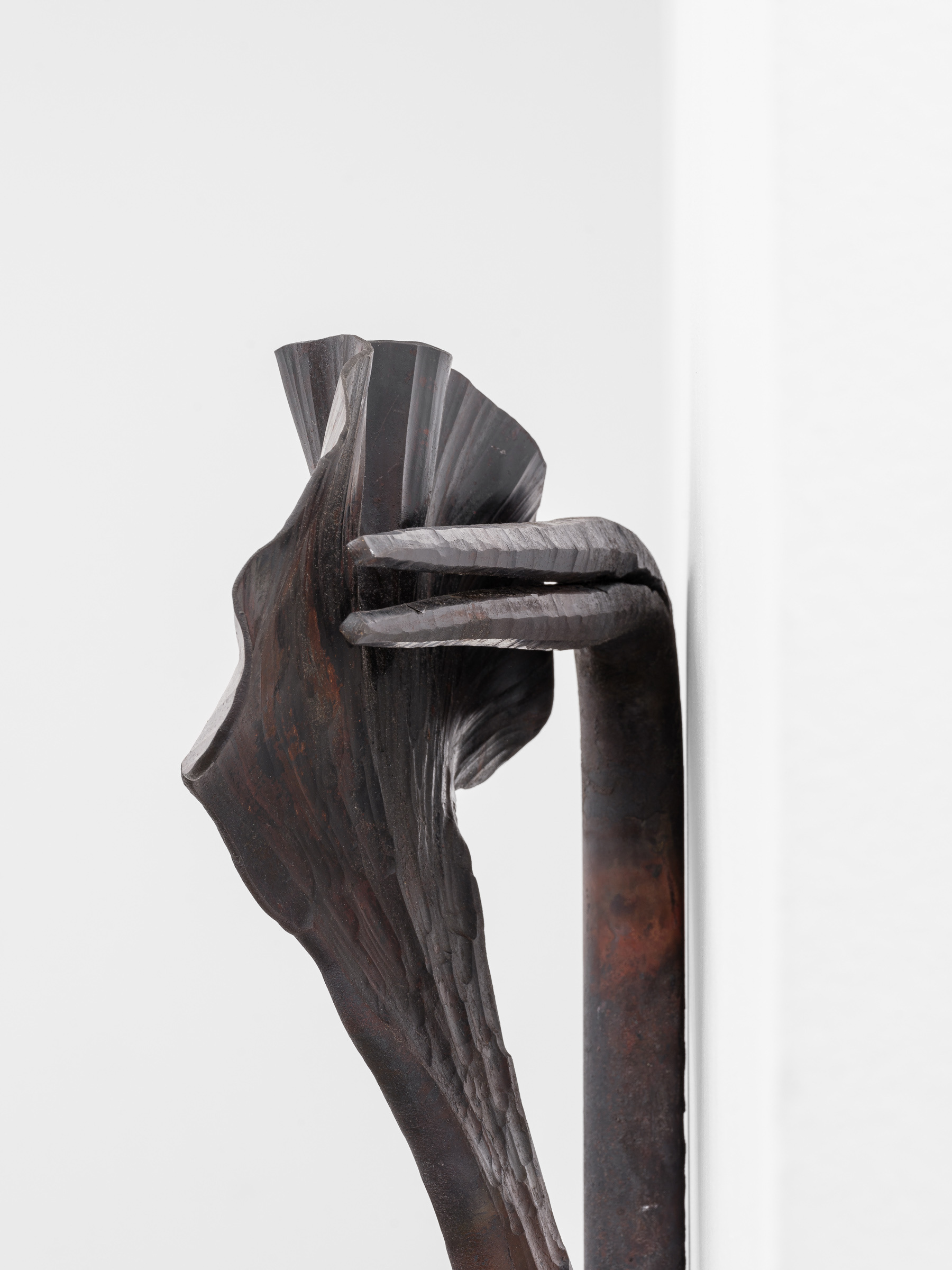
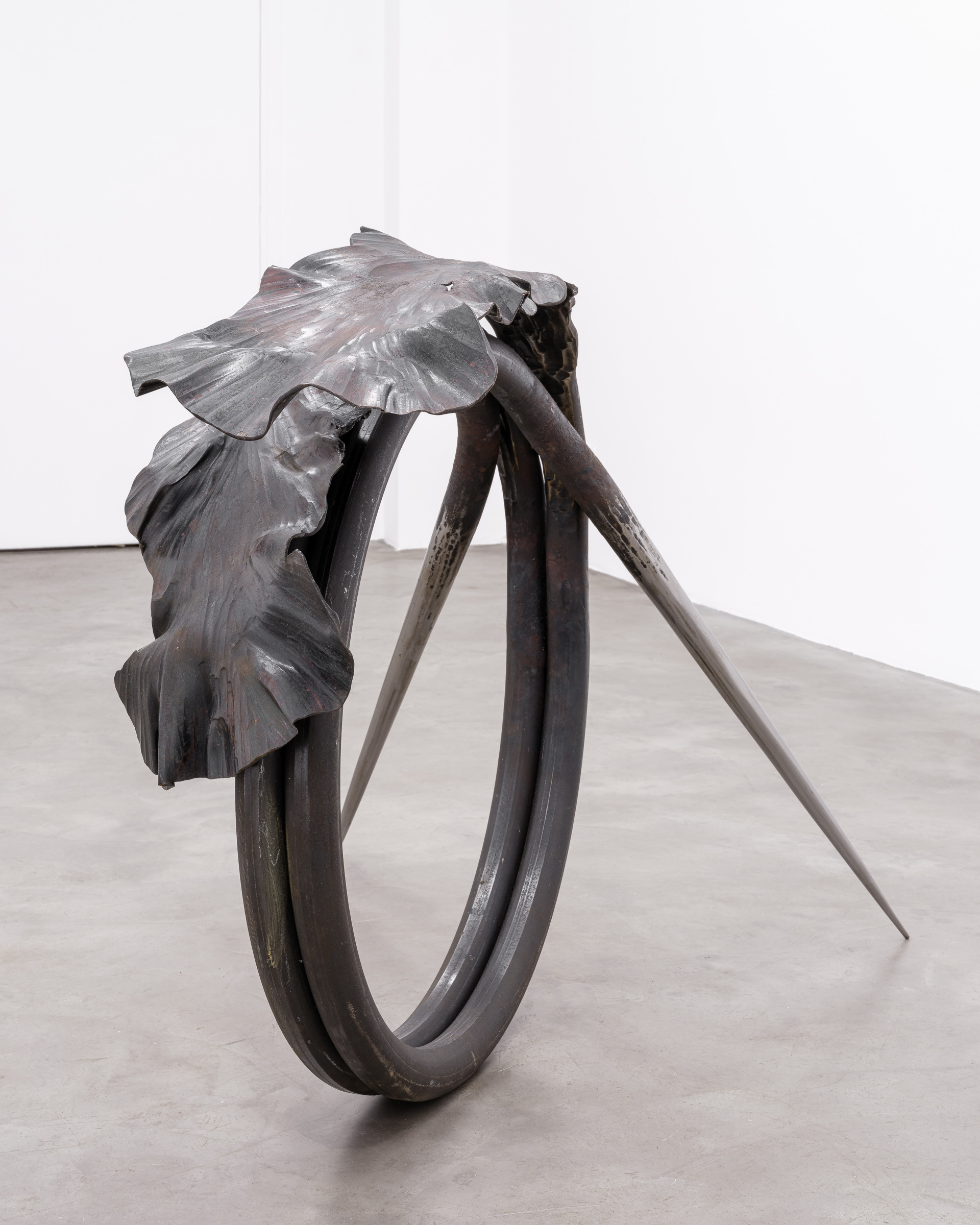
1 2 3
Smile. What face do we allow ourselves to reveal to the other in this millimetered space-time of the retinal trigger? What does that tense expression, piercing gaze, pinched lips, or sharp smile inspire in us? “Tube” is a series of faceless but not moodless sculptures. These new works by artist Lulù Nuti for her eponymous exhibition at GALERIE CHLOE SALGADO have the particularity of being variations of the same iron round bar. Nuti chooses an industrial material as the initial matrix to better explore the multitude of stories this evolving form has to tell us—or keep silent.
The Shy One greets us, withdrawing into itself, yet unable to fully conceal the sharp point rising at its center. It introduces the dual tension that underlies this entire body of work and the exhibition. Frozen in a spiraling gesture, it draws us into its movement as much as it repels us. Devoid of a base, the Tubes extend into space, finding support as much on the ground as on the walls, emphasizing a sense of choreographed momentum. This dance begins from the very inception of the work, in its germinal state. The artist narrates the forms, mimicking the energy of each sculpture. Like a mold or its counterform, her body becomes the preliminary medium of the piece. By sketching the metal’s movements in space, she communicates the intentions of the form to Jadran Stenico, the blacksmith she has collaborated with since 2017 to create her wrought iron pieces. This gestural and sensitive creation process becomes a language in itself, introducing a fundamental approach that engages the discursive qualities embedded in every material.
In Lulù Nuti’s work, one can detect a continuity with certain post-minimalist and Anti-form principles, which suggest that material takes shape through its inherent qualities and the distinctive marks that time and workshop treatments have left on its surface. Her plastic vocabulary, stripped of representations, primarily seeks a mode of expressiveness affected by gesture, wear, and tension, which imprints itself in the memory of the material. The layers of its history are revealed primarily through the coexistence, in a single piece, of different states of the material. Sometimes left raw from machining, the ends and faces of the pieces are worked in distinctive ways—sculpted, forged, polished. Nuti thus treats her tubes in all the dimensions that the material, volume, and spatial arrangement allow.
1 2 3
Green light. Orange light. Red light. They strike a pose. Lulù Nuti’s sculptures have the power of forms in full potency. Supple bodies that leap forward in a movement captured as the expression of a character, whose head and tail suggest a zoomorphic form that guides the reading of the gesture. These two extremities of the tube, however, represent neither beginning nor end. Like the worm with its morphological peculiarity where front and back blur, its vital movement is both linear—forward— and expansive—around. Its entire skin breathes. The two forms characterizing the ends of these tubular bodies—a point and a membrane—could just as easily represent two simultaneous states, in action or potential, of this tubular life. One active state of aiming, penetration, extraction, elongation, or even attack; and another of modesty, in a gesture of epidermal expansion, covering, flexibility, and preservation.
The ambiguity enabled by these ambivalences is a modus operandi for Lulù Nuti, who continuously explores the dialectic between saying and doing, idea and gesture, appearance and being. The moods inhabiting the exhibition space—shy, elusive, secretive, fearful, observing—stem from this dual relationship that characterizes an equivocal mode of being and being in relation to the other. The Tubes, it seems, play sentry, simultaneously desiring and repelling an attraction point that guides us through the exhibition space. They occupy ambivalent positions and attitudes, oscillating between defense and offense. While the Fearful One hides against the wall, the Watcher peers through its hammered surface. Intentions remain masked, and the modesty at work blends with an attempt at camouflage. Nothing is revealed at a single glance. Thus, curiosity and desire are aroused, making the art of unveiling operative.
By constantly eluding us, the Tubes force us to join the dance, to move in order to shift perspectives, alter centers, and multiply viewing angles in a contrary pursuit of revelation that strives to grasp an immediate and intelligible unity. Inevitably failing to contain the integrity of the piece, we are confronted with the impossibility of seeing two things at once, activating an awareness of the potential for a multitude in power. Nuti thus works to bring forward the vital energy residing in the hidden potential of all things without corrupting it. To do this, she nurtures a relationship of doubt with the object, prompting movements of reversal and back-and-forth through games of rupture, dissonance, or exhaustion of the material and its forms. Despite the seemingly brutal nature of wrought iron, this approach, pushed to its limits, seeks finesse and flexibility, and does not exclude a form of sensuality.
1 2 3
Rock, Paper, Scissors. The importance of gesture. Three smaller wall sculptures occupy an exceptional place in the exhibition. Still made from the same initial module, the tube in this case stretches to form a hand. Like an amputated limb, the other end is a rough cut, revealing not the hollow but the solid interior of the iron section. The hand-shape varies according to three potentials: closed, open, folded. Contrasting with the methodical rigor to which the artist remains faithful, the quest for movement that she brings to life in her forms, as we have seen, draws on modes of play, defiance, and even risk. The game of Rock, Paper, Scissors, in its confrontation with the opponent, is a form of calculated chance. The choice of gesture is voluntary but limited and will be dictated by the mutual experience of the two players. This game is among the most archaic, having traversed civilizations, often used to "draw lots," make decisions, or settle situations by relying on the gods or simply fate. The completion of a gesture has the potential to alter the course of things.
The presence of these three anatomical ex-votos in the exhibition clarifies the materialistic approach that infuses Nuti's work, asserting both the energetic and affective charge incorporated into the object and the fundamental role of the hand’s relationship with the material. This is particularly significant in all artisanal practices, but even more so for the blacksmith, whose technique originally stems from the art of toolmaking. The hand, the tool, and the form merge, symbolizing, by metonymy, the continuity and reciprocity of agency between technique and material, gesture and form. While the three pieces unequivocally illustrate popular playful practices of games and wagers, their representation as fragmentary limbs also invokes their symbolic and emotional functions, akin to popular votive practices.
Nuti more explicitly reveals the signs and images that inform her research without showing them in the more abstract forms that usually constitute her plastic vocabulary. The Tubes thus carry a denser, more complex significance. In these elongated beasts, new metaphorical intentions emerge. Some of the sculptures twist, folding back onto themselves until they penetrate one another. Here, the Ouroboros motif—the serpent biting its tail—becomes a central figure in the exhibition. While this symbol is often associated with protective and regenerative qualities, the physiological phenomenon of autophagy, observed in snakes and linked to this image, arises from a lethal survival mechanism. When exposed to excessive heat, they devour themselves in a final attempt at regulation. The serpent or worm also refers to the massive drill head used to bore tunnels through mountains. During a residency at a drilling site, Lulù Nuti experienced this steel worm devouring rock with a shrill sound, regurgitating the mountain's innards as a viscous magma. In response to the invader, the mountain overheats, protecting itself in turn. From autophagy to geological fever, and through to molten iron shaped by the hammer, the drive for creation and preservation of life becomes a conversation with fire.
Noémie Pacaud
_
In the fall of 2024, Lulù Nuti is presenting her third solo exhibition at GALERIE CHLOE SALGADO. This exhibition marks her return to France after numerous institutional exhibitions in Italy; her first institutional solo presentation, IN MY END IS MY BEGINNING, showcased at Palazzo Collicola, the museum of modern art of Spoleto) having just ended. This project was born from the encounter between the artist and scientists from the European Gravitational Observatory in Cascina (Italy), who welcomed and guided her to explore one of the major scientific research topics of our time: that of the absolute and the limits of matter. The wrought iron sculpture (135 x 200 cm) resulting from this collaboration reflects the artist's interest in investigating the world around her and her desire to understand it by bringing together different disciplines. The work, with its rounded and symmetrical forms, recalls ancient symbols that preceded scientific investigations but which, due to their analogical and non-analytical nature, seem to anticipate some of today's most acclaimed theories: the self-generation and self-sufficiency of a universe that self-fertilizes to infinitely repeat a cycle of expansion and contraction.
Continuing with her reflections on regenerative cycles, the artist imagined and created DANZANTE DORMIENTE in June 2024, a wrought iron serpent sculpture over thirteen meters long, which coils around the central fountain of the garden of the National Academy of San Luca (Roma), following the invitation of Stefano Chiodi.
For Tube, her third solo exhibition at GALERIE CHLOE SALGADO, Lulù Nuti continues her exploration of these questions and investigates the properties of iron, a material she sculpts and transforms into a moving body, whose initial rigidity gives way to more organic forms. Her approach remains rooted in an intellectual and sensitive engagement with matter, which becomes a vehicle for a poetic language where the intimate merges with generational inquiries. The exhibition is accompanied by a text by Noémie Pacaud.
More broadly, Lulù Nuti questions the relationships between humans and their environment, and her work becomes a space for projection, where viewers can nestle and let their gaze read a landscape that is both gentle yet harsh, familiar yet chaotic. Her works materially transpose the rupture she identifies in the relationships between humans, their ecosystem and their time.
Lulù Nuti (1988, Levallois-Perret) lives and works in Rome. After spending her childhood in Rome, Nuti moved to Paris in 2006 to attend the École Nationale Supérieure des Beaux-Arts, graduating in 2012. Since then, she has participated in numerous group and solo exhibitions, both in galleries (GALERIE CHLOE SALGADO, Renata Fabbri, Galleria Alessandra Bonomo, Galleria Mazzoli, Postmasters, etc.) and institutions (Villa Medici, Musée des Beaux-Arts d’Angers, Fondazione Nicola Del Roscio, Accademia di Belle Arti di Roma, Museo Camusac, Collezione La Gaia, Galleria nazionale d'arte moderna e contemporanea, etc.).
Noemie Pacaud



